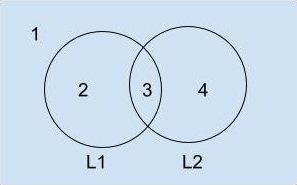The options should be $b,c,d$.
Options –
(a) The Complement of CFL is Recursive. The intersection of Recursive and Regular is Recursive.
(b) It is $L_1 \cap L_2$ and intersection of CFL and regular is CFL.
(c) It is $\Sigma^*$ itself as $L_2 \cup \bar{L_2}$ is $\Sigma^*$ and union of $\Sigma^*$ and $L_1$ is $\Sigma^*$ which is regular and thus CFL.
(d) Solving this you will get $L_2$ which is CFL. See the image below.

We can write the $(d)$ option as,
$= (23 \cap 34) \cup (14 \cap 34)$
$= (3) \cup (4)$
$= L_2$